Many people like to keep aquariums in their homes or offices. They are a great decoration and provide a calming environment.
Aquarium plants are used to add color and beauty to the tank. There are many different types of plants that can be used in an aquarium.
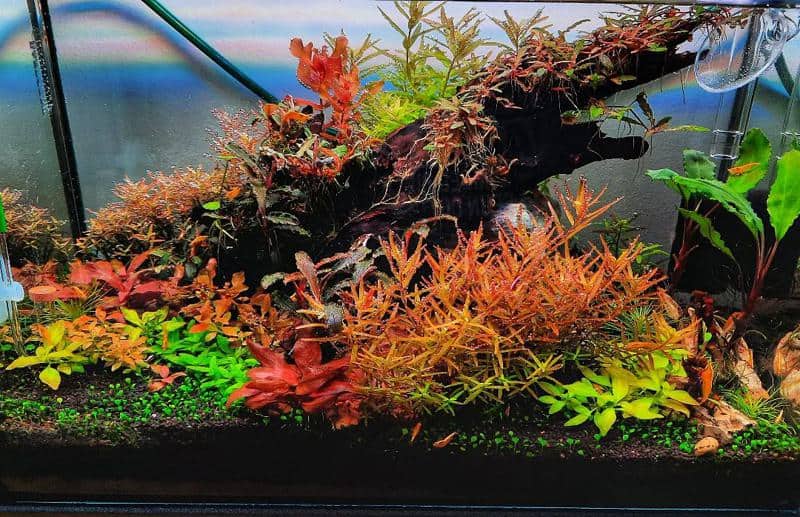
They all have their pros and cons. For example, some plants are a bit difficult to maintain but they create a lot of oxygen for fish.
In this article, we will talk about red aquarium plants. These plants are the new trend in the world of fish tanks. They provide a natural environment for fish and are easy to maintain in general.
12 Best Red Aquarium Plants for Every Fish Tank
Red aquarium plants look beautiful whether they are placed in the middle or on the side of the tank. Some are more compact while others have long stems that reach down to the bottom of the aquarium.
These plants come in different shapes and sizes. So there are a lot of options to choose from.
We’ve selected the best ones for you. This will help you narrow down your choices and find the options that fit your needs.
Here are the 12 best red aquarium plants:
- Red Tiger Lotus
- Alternanthera Reineckii
- Lagenandra Meeboldii Red
- Ludwigia Glandulosa
- Rotala Macrandra
- Proserpinaca Palustris
- Rotala Yao Yai
- Ludwigia Repens
- Bacopa Colorata
- Persicaria Sao Paulo
- Rotala Wallichii
- Ludwigia Arcuata
1. Red Tiger Lotus
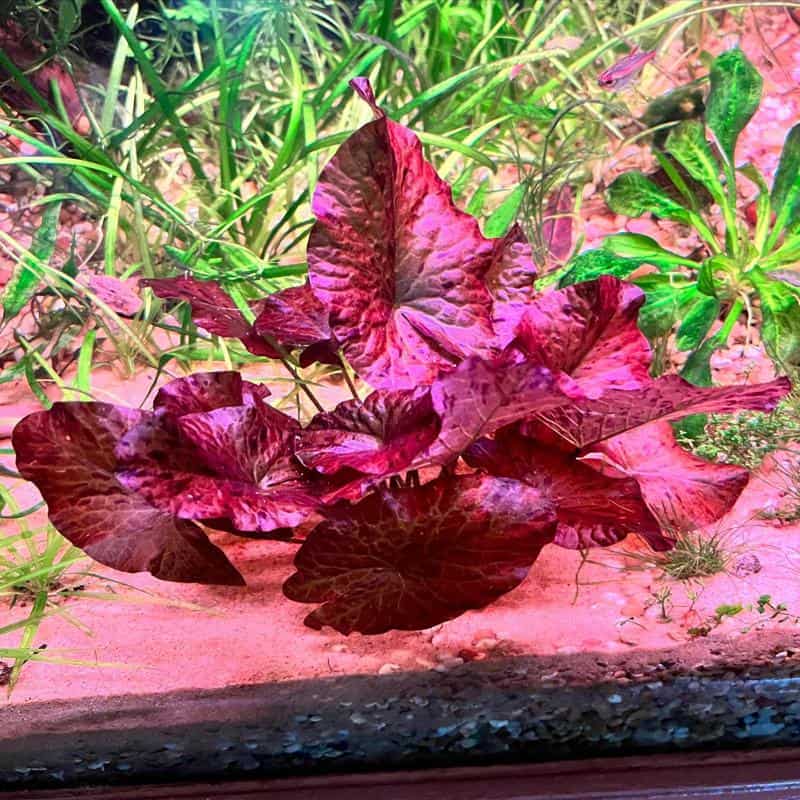
This red-colored aquatic plant originates from Southeast Asia and Africa. Red Tiger Lotus belongs to water lilies.
In nature, it grows in stagnant or shallow waters. It also thrives well in freshwater aquariums and can grow quickly without any special care.
What makes this hardy species popular with aquarists is its reddish wide leaves. Keep in mind that the leaves may start turning green if there is no sufficient iron in your tank.
Be sure to provide it with plenty of nutrients. Otherwise, Red Tiger Lotus can easily deprive surrounding plants of nutritive substances.
You should also limit the growth of this fast-growing plant. Frequent trimming and root containing are methods that can do the trick. Besides, ensure that the seeds don’t spread in your aquarium.
Requirements:
- High light level
- Surface position
- Ample nutrients needed
- No special care
NOTE: The leaves of this plant are not always red. This is particularly true if there’s not enough iron in the aquarium.
Related: Dwarf Aquarium Lily (Nymphae Stellata) Care Guide
2. Alternanthera Reineckii
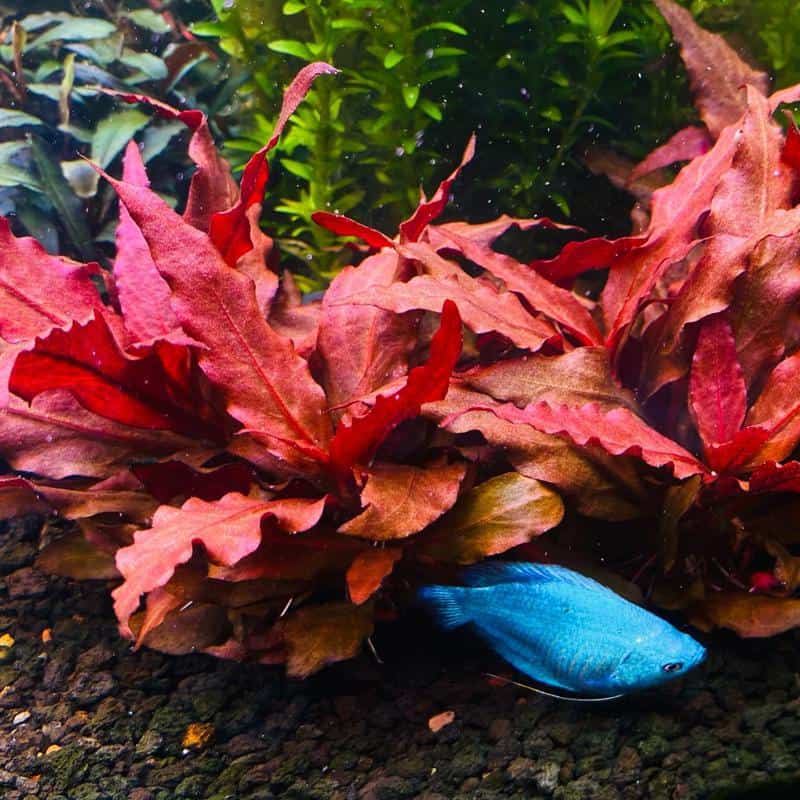
This fragile and demanding aquarium plant is available in a number of varieties. Alternanthera Reineckii Mini is one of the most popular varieties because of its stunning color.
Other fashionable varieties are Rosaefolia and Rosanervig. But you can’t go wrong with any of them. They can all make your tank attractive with proper care. Avoid over-planting!
Trim your plants regularly to encourage their growth. Adding CO2 is also advisable, but it’s not absolutely necessary. CO2 supplementation will boost the growth of your plants.
If you want to achieve healthy growth, provide adequate lighting. Strong lighting can promote algae growth. Remove them with the help of algae eaters because they can suffocate your plants.
Requirements:
- Moderate care level
- Medium-high lighting
- CO2 supplementation
- pH: 5.2-7
3. Lagenandra Meeboldii Red
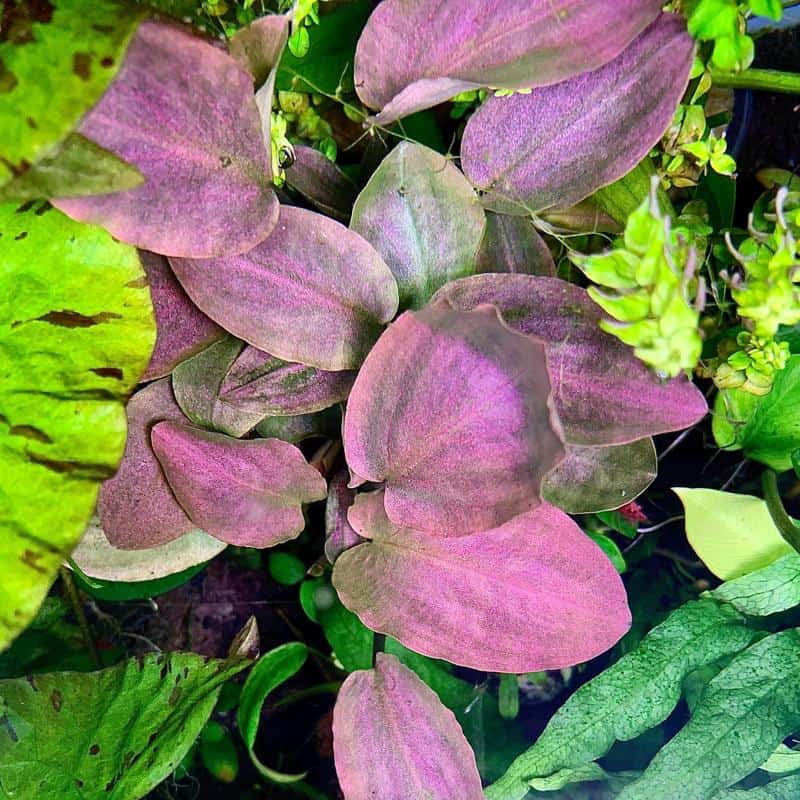
Originating from Southern India, Lagenandra Meeboldii is an aquatic plant that features abundant growth. This medium-sized species can also grow in aquariums without much care.
It is a beginner-friendly plant that can be grown in just about any fish tank. Since this species has a relatively large root system, it’s best to grow it in nutrient-rich substrates.
Although intense lighting and carbon dioxide injection aren’t necessary, this can promote growth while enriching the color of leaves. They have a unique pattern that provides surrounding plants with shadow.
Lagenandra Meeboldii Red is available in a variety of colors. The most popular variants include reddish, violet, green, and bright red.
On the same leaf, there could be various colors (or shades of colors), depending on the growth stage and conditions. The leaves are green in younger plants and they may change to other colors with age.
Requirements:
- Easy care
- Mid-ground position
- CO2 injection isn’t necessary
- High light level
NOTE: Some varieties don’t have red leaves. Also, don’t be surprised if your younger plants have green leaves. They will get red with age, providing that they grow under favorable conditions. CO2 injection and high light levels can enrich their color.
4. Ludwigia Glandulosa
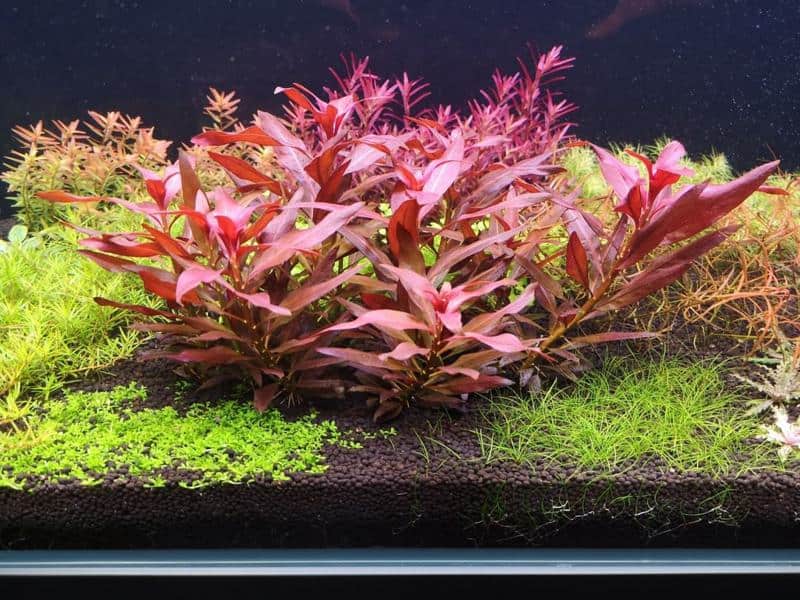
Another freshwater plant that would be ideal for creating a focal point in your tank is Ludwigia Glandulosa. With purple or wine-red leaves, it can add an accent to any aquascape.
Remember that this colorful plant is demanding to maintain and grow. CO2 supplementation and intense lighting are required for the production of the supreme colors. Use a nutrient-rich substrate for the best results.
Apart from that, make sure the water temperature is below 26 °C at all times. These conditions will prevent leaves from falling and ensure that their color doesn’t fade away.
High nitrate levels are also needed for maintaining the striking red color. Lastly, it is worth noting that this aquatic plant develops upright in fish tanks. Be aware of that!
Requirements:
- Background position
- Max temperature: 78°F
- Intense lighting
- Moderate care
5. Rotala Macrandra
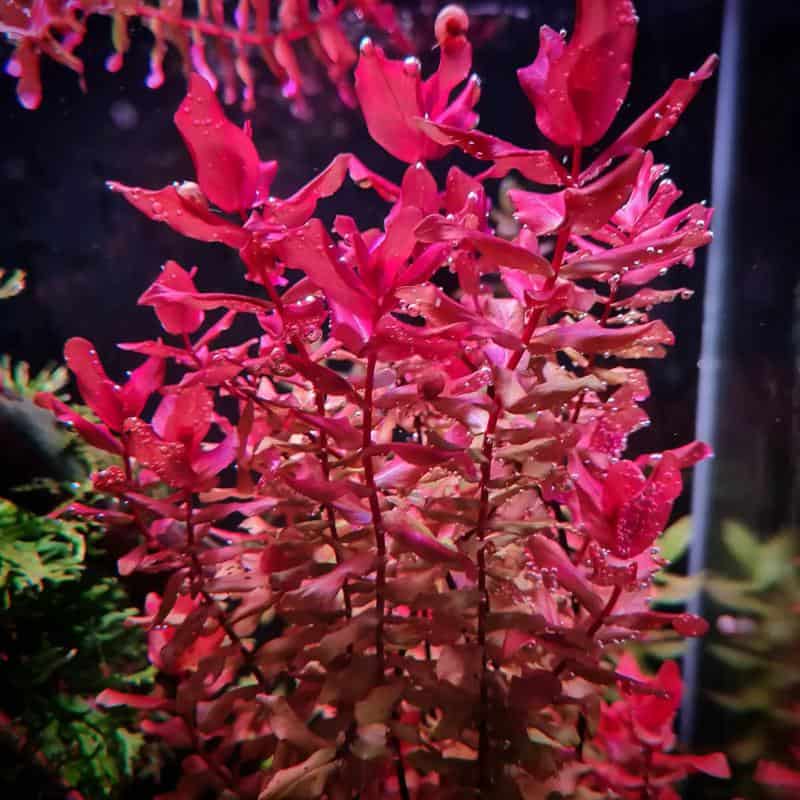
If you’re an experienced aquarist, this demanding fast-growing plant could be perfect for your tank. The most popular type of this aquatic red plant is Rotala Macranda ‘Mini’.
Bear in mind that it is challenging to grow. It’s highly demanding regarding nutrients and requires correct nutrient balance as well as limited nitrates.
The Rotala Macranda plants grow best in soft, acidic waters. Make sure the water in your tank has increased CO2 levels. Without these conditions, their chances of developing red coloration are slim.
With the proper care and maintenance, these stem red plants grow fast. Intense lighting is also necessary for their thriving.
Requirements:
- Background or midground position
- High light level (intense lighting)
- Increased CO2 levels
- Advanced care
6. Proserpinaca Palustris
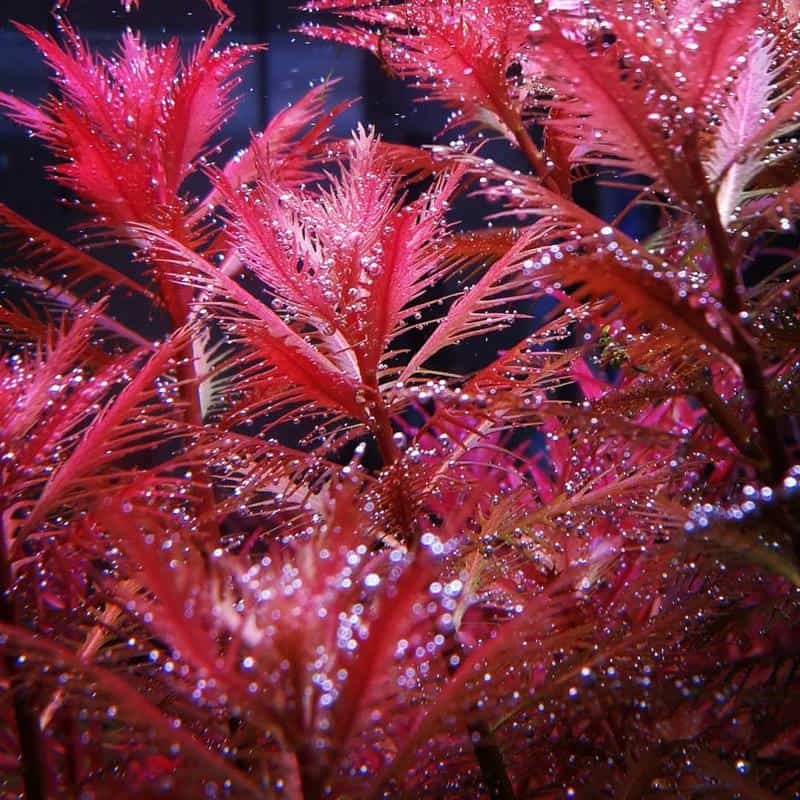
Also called mermaid weed, Proserpinaca Palustris is a red aquarium plant that can create a picturesque visual statement in fish tanks. This is particularly true when it has a foreground position in aquariums.
This herbaceous plant can have different forms. Some plants can be red with fine-toothed leaves while others are green with saw-toothed leaves. Their shade and shape may change in aquariums.
For example, leaves with coarsely serrated edges can transform into delicate tiny combs when the plant is grown under intense lighting. Likewise, their color may change from vibrant green to red or pink.
To thrive and look their best, plants need adequate lighting as well as sufficient carbon dioxide and nutrients. Frequent trimming is not required since these plants don’t grow quickly.
Requirements:
- High light level
- Foreground position
- It needs plenty of nutrients and CO2
- Moderate care
NOTE: If you exclusively seek red plants, look for varieties with fine-toothed leaves. Additionally, provide your plants with intense lighting as well as plenty of nutrients and sufficient CO2. That will cause them to develop reddish leaves.
7. Rotala Yao Yai
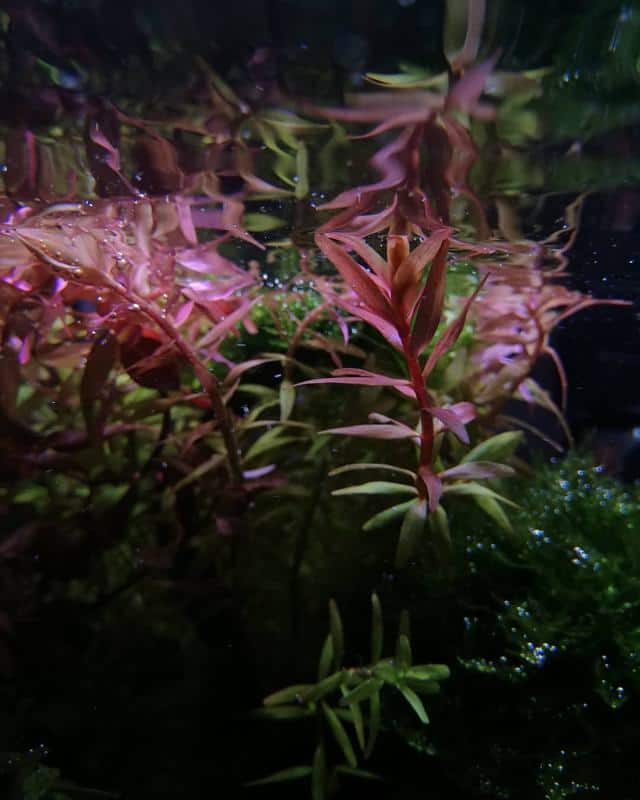
Many aquarists have never heard of Rotala Yao Yai. Even so, this underrated plant is a good choice for almost any aquarium.
The branches boast an orange or red hue that makes them stand out from other plants in the aquarium. This vivid species is excellent for aquascaping. It usually has a background position in fish tanks.
If you want to grow Rotala Yao in your tank, make sure it is suitable for this species. In order to create a bushy appearance, trim your plants properly and regularly. No specialty is needed for this easy chore.
You can uproot the plants and replant them again if required. That makes Rotala Yao Yai a great option for beginners.
Requirements:
- High light level
- Background position
- Moderate care
- Beginner friendly
8. Ludwigia Repens
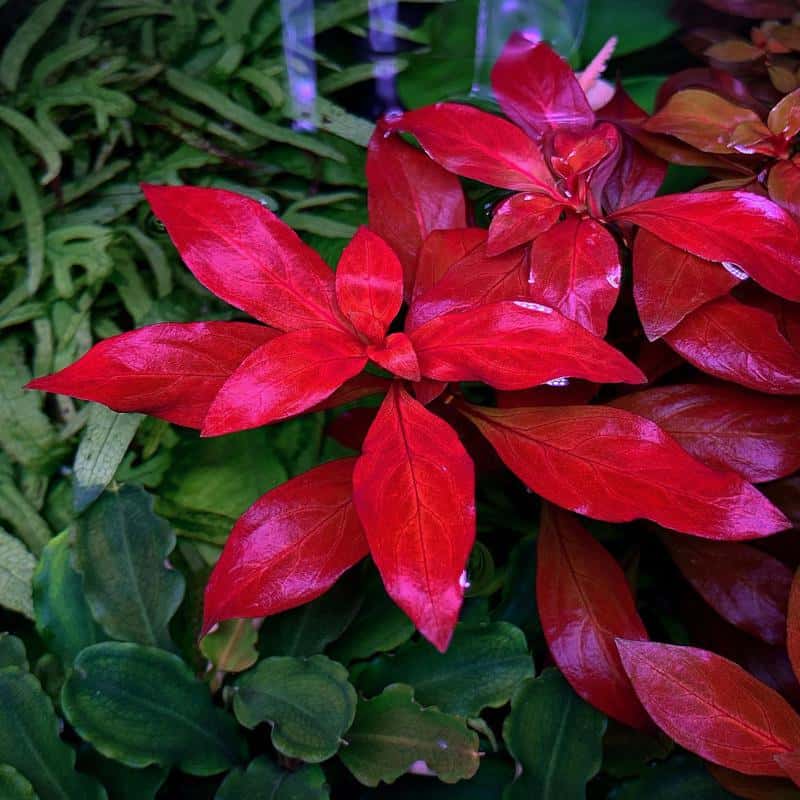
Here’s another beginner-friendly plant. Ludwigia Repens is ideal for beginner aquarists because it is easy to maintain and grow.
This beautiful aquarium red plant is a good fit for any aquascaping theme. Be sure to pick a reddish plant with healthy leaves when shopping for it to reduce the risk of parasite infection or disease. It can be bought in most fish stores.
Look for plants that are still young. They are more likely to grow best and will have a lot of time to get used to the environment in your aquarium.
Ludwigia Repens is a species that can propagate rapidly, meaning you will be able to populate the entire tank from several stems only. If you have a small fish tank, limit their growth by using just a few stems.
Requirements:
- Background or mid position
- Can grow in any substrate
- Medium lighting
- Easy care
9. Bacopa Colorata
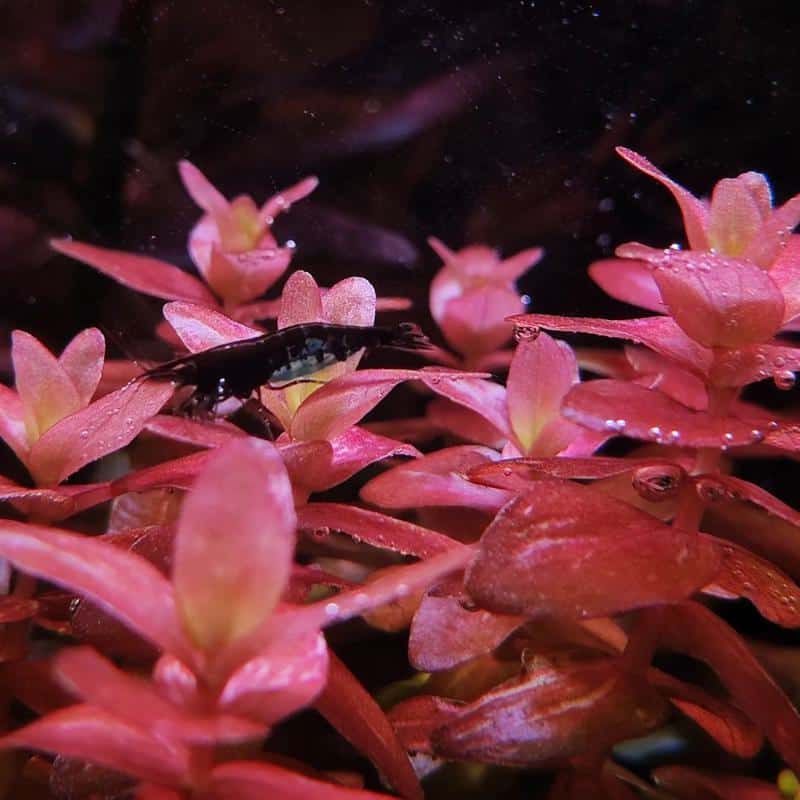
We’ve selected another low-demanding plant for beginners. If you don’t want to put a lot of effort into caring for your aquarium plants, then Bacopa Colorata could be a good choice.
You would be able to plan and decorate your tank effortlessly with this amazing plant. It grows slowly, branching out from the base. That gives an extremely spectacular look to aquariums.
Bacopa Colorata can thrive in both large and small tanks alike. It can survive in the poor substrate without carbon dioxide injection. No extra light sources are required for the growth.
This versatile plant grows well even in low lighting. While normal daylight would be quite enough, you should install additional lights to get the top-notch color of your leaves.
Despite the fact that this modest plant doesn’t require anything special, take care of it to achieve robust growth. Good aquarium conditions will also result in vivid colors.
Requirements:
- Mid-ground position
- Low to medium lighting
- Easy to grow
- Low demanding
10. Persicaria Sao Paulo
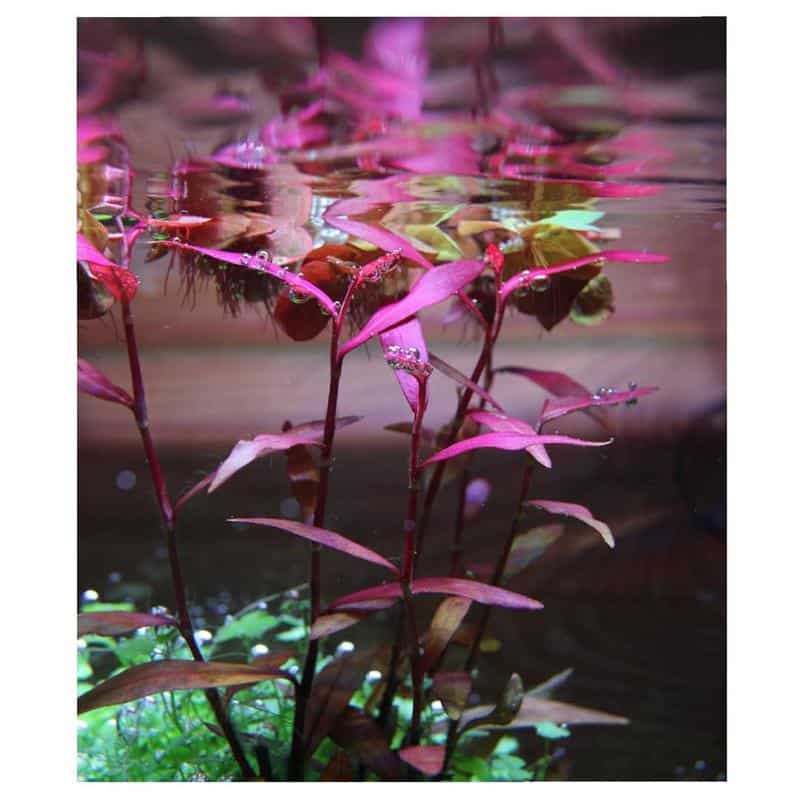
As the name suggests, this plant originates in Brazil. Persicaria Sao Paulo looks nice in most aquariums, especially when placed in the middle along with green plants.
With magenta leaves, it will make your tank impressive. This vibrant plant grows moderately when it has good growing conditions.
As for the water parameters, it is not demanding at all. Moderate lighting is preferred. However, it can also be grown under low lighting.
All you need to do is prune the upper parts of the stems to propagate your plants. After putting them into an adequate substrate, they will start to develop and create new leaves.
Requirements:
- Moderate care
- Mid-ground position
- Intense lighting
11. Rotala Wallichii
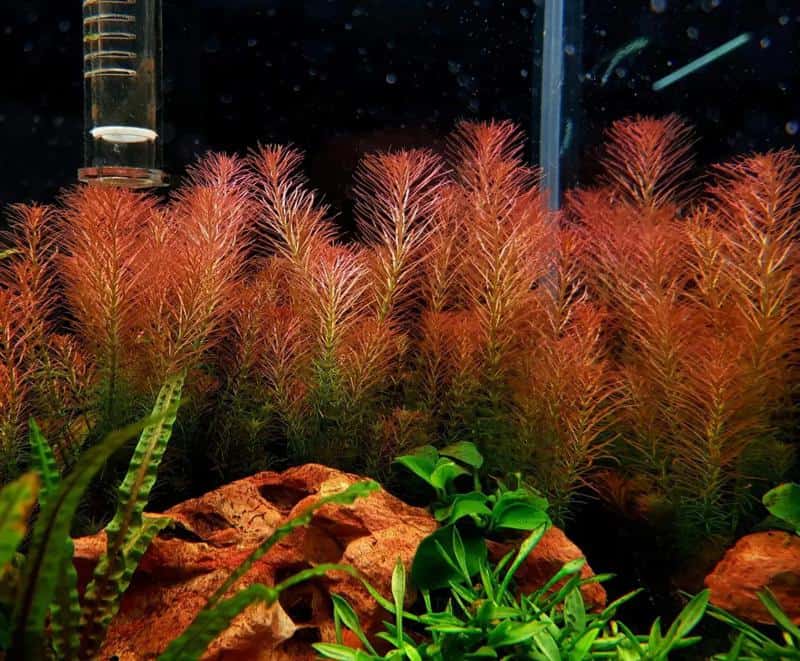
With elongated red or pink leaves and purple flowers, this stem plant is very popular with hobbyists. But it is not suitable for beginners either. It’s definitely not an easy aquatic plant to grow and maintain.
Rotala Wallichii requires abundant lighting to thrive. Support with nitrate, iron, and carbon dioxide is also required. Make sure the phosphate levels are high in your tank if you want to grow this plant.
Yes, Rotala Wallichii is challenging to grow. However, this shouldn’t discourage you from choosing it for your aquarium.
Given the proper conditions, it is quite rewarding. As a background or midground aquarium plant, tall plants can reach the waterline and develop beautiful red or pink stems. It’s worth it!
Requirements:
- Background or midground position
- Advanced care level
- CO2 injection needed
- High light demands
NOTE: Plenty of light is required for the red coloration of leaves. If you have a plant with green leaves, the light can change its color. Aside from intense lighting, you should support it with nitrate, iron, phosphate, and CO2.
12. Ludwigia Arcuata
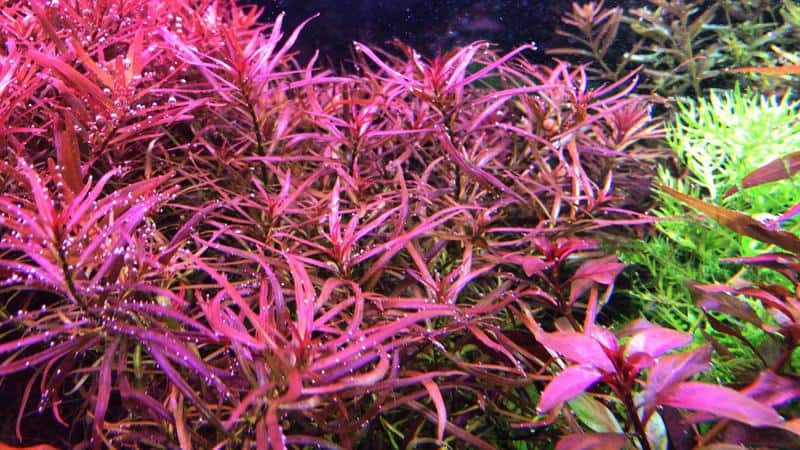
Whether it has green or delicate red leaves, this easy-to-maintain plant looks great in aquariums. Ludwigia Arcuata has pointed needle leaves that typically grow along the stems in opposite pairs.
It can be grown either emersed or submerged. If you want to cultivate this aquatic plant in your tank, remember that it requires bright illumination and nutrients. That’s critical for the desirable reddish color.
Your plant would also appreciate higher iron levels in the water. That can make a big difference in their coloration.
Don’t forget to provide them with CO2 injection, too. This can do a good job of supporting robust growth!
Requirements:
- Background or midground position
- Easy to grow and maintain
- Intense lighting required
NOTE: It’s worth noting that bright illumination, CO2 injection, and nutrients are critical for the desirable red color. Higher iron levels are also important for coloration.
Also Read:
- Best Aquarium Plants with Flowers
- Best Aquarium Plants for a Sandy Substrate
- Best Carpet Plants for Aquarium
- Best Aquarium Plants That Grow Tall
FAQs
How Do You Keep Your Aquarium Plants Red?
If your aquarium plant doesn’t turn red, you need to increase the intensity of lighting. Another reason could be insufficient duration time. Consider extending the lighting period by one to two hours and track the results.
While light is the most important factor in coloration, nutrients and plant fertilizers also play a role in changing the color of leaves. Red aquarium plants are more likely to turn orange or green when using a nitrate-rich fertilizer.
Do Red Aquarium Plants Need Carbon Dioxide?
The answer to the question depends on the type of plants and their environment. Some plants need carbon dioxide while others don’t.
Plants that do not need carbon dioxide are called autotrophs. They can make their own food from inorganic substances like CO2 and H2O. Autotrophs are usually found in aquatic environments or places where there is no sunlight for photosynthesis.
Carbon dioxide (CO2) is no doubt of great importance for the growth and development of red aquarium plants. While CO2 is not as important as lighting for coloration, it can make a difference.
An aquatic plant that appears greenish with adequate carbon dioxide levels may get a red accent. What’s more, some green aquatic plants can become totally red.
How Can You Get Richer Colors and Stronger Reds?
To obtain rich colors and strong reds in your aquatic plants, make sure they get sufficient iron in your aquarium. Consider adding liquid fertilizers or iron tablets to the water in order to supply this nutrient.
Next, provide adequate lighting for your red aquarium plants. They need a lot of light to have rich colors and strong red colors. With that being said, consider adjusting the lighting if needed.
Lastly, add liquid fertilizers that are designed specifically for them. That will allow your red aquarium plants to achieve richer colors and full potential.
Final Thoughts
Now you know the best red plants for your tank. With their vivid colors, these decorative plants can add aesthetics and prettiness to your aquarium.
These plants are really beautiful. However, the best part about them is that they also act as a form of natural filtration for fish tanks. Their roots will work to clean up the water in your tank.
Sometimes they may have some extra requirements, such as regular fertilization and special lighting setups. But it’s worth the effort.
We hope this post helped you choose the best red aquatic plant(s) for your tank. Happy growing!